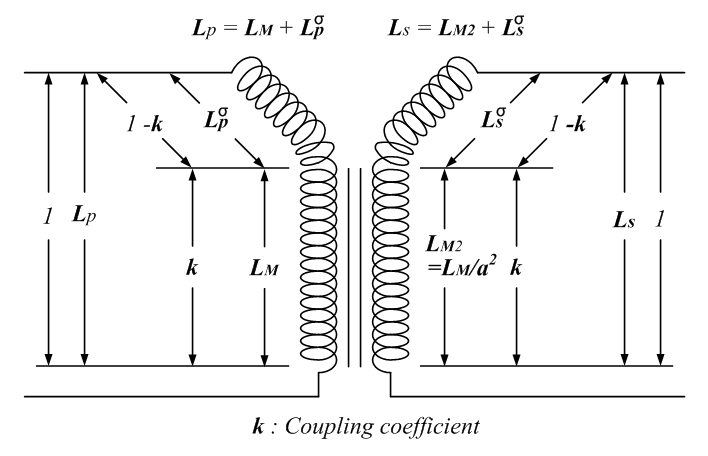 | ||
Leakage inductance derives from the electrical property of an imperfectly-coupled transformer whereby each winding behaves as a self-inductance constant in series with the winding's respective ohmic resistance constant, these four winding constants also interacting with the transformer's mutual inductance constant. The winding self-inductance constant and associated leakage inductance is due to leakage flux not linking with all turns of each imperfectly-coupled winding.
Contents
- Leakage inductance and inductive coupling factor
- Inductive leakage factor and inductance
- Refined inductive leakage factor
- Leakage inductance in practice
- Measurement of inductive coupling factor
- References
The leakage flux alternately stores and discharges magnetic energy with each electrical cycle acting as an inductor in series with each of the primary and secondary circuits.
Leakage inductance depends on the geometry of the core and the windings. Voltage drop across the leakage reactance results in often undesirable supply regulation with varying transformer load. But it can also be useful for harmonic isolation (attenuating higher frequencies) of some loads.
Although discussed exclusively in relation to transformers in this article, leakage inductance applies to any imperfectly-coupled magnetic circuit device including especially motors.
The terms inductive coupling factor and inductive leakage factor are in this article as defined in International Electrotechnical Commission Electropedia's IEV-131-12-41, Inductive coupling factor and IEV-131-12-42, Inductive leakage factor.
Leakage inductance and inductive coupling factor
The magnetic circuit's flux that does not interlink both windings is the leakage flux corresponding to primary leakage inductance LPσ and secondary leakage inductance LSσ. These leakage inductances are defined in terms of transformer winding open-circuit inductances as well as the transformer's coupling coefficient or coupling factor k, the primary open-circuit self-inductance being given by
where
and
It therefore follows that the transformer secondary open-circuit self, magnetizing and leakage inductances are given by
Inductive coupling factor k is given as
where
and
The electric validity of the above transformer diagram depends strictly on open circuit conditions for the respective winding inductances considered, more generalized circuit conditions being as developed in the next two sections.
Inductive leakage factor and inductance
A real linear two-winding transformer can be represented by two mutual inductance coupled circuit loops linking the transformer's five impedance constants as shown in the diagram at right, where,
The nonideal transformer's mesh equations can be expressed by the following voltage and flux linkage equations,
These equations can be developed to show that, neglecting associated winding resistances, the ratio of a winding circuit's inductances and currents with the other winding short circuited and at no-load is as follows,
where,
The transformer can thus be further defined in terms of the three inductance constants as follows,
where,
The transformer can be expressed more conveniently as the first shown equivalent circuit with secondary constants referred (i.e., with prime superscript notation) to the primary,
Since
and
we have
which allows expression as second shown equivalent circuit with winding leakage and magnetizing inductance constants as follows,
The nonideal transformer can be simplified as shown in third equivalent circuit, with secondary constants referred to the primary and without ideal transformer isolation, where,
iM = iP - iS' ------ (Eq. 2.14)iM is magnetizing current excited by flux ΦM that links both primary and secondary windings.iS' is the secondary current referred to the primary side of the transformer.Refined inductive leakage factor
Referring to the flux diagram below at left, primary driven and the secondary open-circuited, the following equation holds:
σP = ΦPσ/ΦM = LPσ/LM ------ (Eq. 3.1)In the same way,
σS = ΦSσ'/ΦM = LSσ'/LM ------ (Eq. 3.2)And therefore,
ΦP = ΦM + ΦPσ = ΦM + σPΦM = (1 + σP)ΦM ------ (Eq. 3.3)ΦS' = ΦM + ΦSσ' = ΦM + σSΦM = (1 + σS)ΦM ------ (Eq. 3.4)LP = LM + LPσ = LM + σPLM = (1 + σP)LM ------ (Eq. 3.5)LS' = LM + LSσ' = LM + σSLM = (1 + σS)LM ------ (Eq. 3.6),where
The leakage ratio σ can thus be refined in terms of the interrelationship of above winding-specific inductance and Inductive leakage factor equations as follows:
Leakage inductance in practice
Leakage inductance can be an undesirable property, as it causes the voltage to change with loading.
In many cases it is useful. Leakage inductance has the useful effect of limiting the current flows in a transformer (and load) without itself dissipating power (excepting the usual non-ideal transformer losses). Transformers are generally designed to have a specific value of leakage inductance such that the leakage reactance created by this inductance is a specific value at the desired frequency of operation.
Commercial transformers are usually designed with a short-circuit leakage reactance impedance of between 3% and 10%. If the load is resistive and the leakage reactance is small (<10%) the output voltage will not drop by more than 0.5% at full load, ignoring other resistances and losses.
High leakage reactance transformers are used for some negative resistance applications, such as neon signs, where a voltage amplification (transformer action) is required as well as current limiting. In this case the leakage reactance is usually 100% of full load impedance, so even if the transformer is shorted out it will not be damaged. Without the leakage inductance, the negative resistance characteristic of these gas discharge lamps would cause them to conduct excessive current and be destroyed.
Transformers with variable leakage inductance are used to control the current in arc welding sets. In these cases, the leakage inductance limits the current flow to the desired magnitude.
Measurement of inductive coupling factor
The inductive coupling factor is derived from the inductance value measured across one winding with the other winding short-circuited according to the following:
Per Eq. 2.7,